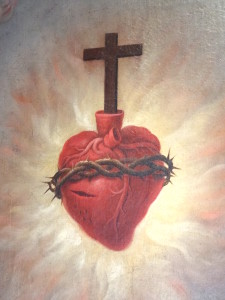The Sacred Heart (also known as the Sacred Heart of Jesus) has one of the deepest meanings in the Roman Catholic practice. The symbol represents Jesus Christ’s actual heart as His love for all of humanity. The Sacred Heart can be depicted a few different ways.
The most common depiction is of the heart has a circle of thorns that represent the crown of thorns that was placed on Jesus’ head. It also may have a cross, which represents the Crucifixion. Other symbols may have a flame or light surrounding it, which signifies the divine light of love. You will mostly see the Sacred Heart in a portrait of Jesus Christ.
History of the Sacred Heart

The earliest known devotion to the Sacred Heart occurred around the eleventh century. Saint Bernard was a proponent of beginning the devotion to the Sacred Heart, since he concluded that Jesus’ side being pierced was indicative of his devotion and love toward humanity. Since that time, hymns have been written about the Sacred Heart and churches have portraits of the symbol in many places. Some of the notable saints who were strong promoters of the Sacred Heart include Saint Gertrude, Saint Lutgarde and Saint Margaret Mary.
In the 14th century, Pope Innocent VI officially indicated that the Sacred Heart should be honored and worshipped. From that point on, the Sacred Heart continued to grow as a major symbol of worship throughout the Roman Catholic religion. The vision of the symbol spread throughout the world and became a worldwide symbol of love and devotion.
Worshipping the Sacred Heart
The Feast of the Sacred Heart was introduced in 1856 and has been celebrated every year since then, which occurs 19 days after Pentecost. The first country in the world to be consecrated to the Sacred Heart was Ecuador.
The worship of the Sacred Heart can be done in a variety of forms. The most common forms of worship include hymns, the Litany of the Sacred Heart and also the Salutation of the Sacred Heart. Roman Catholic services worldwide still follow these practices today.
Roman Catholics also have a practice that allows the Sacred Heart into their home. This ceremony is known as the Enthronement of the Sacred Heart, and it occurs when a priest enters a home to bless the Sacred Heart. Either a picture or a statue of the Sacred Heart is blessed and placed in a special location in the home to serve as a reminder of worship and devotion. When in the home, the Sacred Heart signifies the foundation of God’s kingdom amongst individuals and families.
Depictions of the Sacred Heart
The Sacred Heart symbol can be found in Catholic churches and homes across the world. It can be represented as a picture, statue, art in stained glass or any other depictions. When the image is displayed in homes, it is common to have the names of the family members engraved near the symbol as a reminder that each member of the family is being protected by Jesus in the Sacred Heart.
The Sacred Heart can also be seen in combination with other religious symbols. The Immaculate Heart of Mary is the most common symbol that is shown with the Sacred Heart, but it is generally pierced with a sword instead of crowned with thorns. The combination of these two symbols reflects the joining and the binding of the two hearts.
The Sacred Heart Brings Peace
Among other things, the Sacred Heart brings peace to families and individuals because of what it signifies. Even though the Sacred Heart suffered in the past, the light still shines brightly and brings warmth during tough times. Worshipping the Sacred Heart during tough times brings some of the most peaceful moments to families and individuals because of the unconditional love that is symbolizes.
When people pray to the Sacred Heart, they will often feel a greater sense of security knowing that they are being watched over and protected. That is one of the many reasons why Roman Catholics wish to have a depiction of the Sacred Heart in their homes to serve as a reminder. Above all else, the Sacred Heart is a clear reminder of the love and devotion of Jesus to all of humanity, despite the suffering that has been and still is endured.